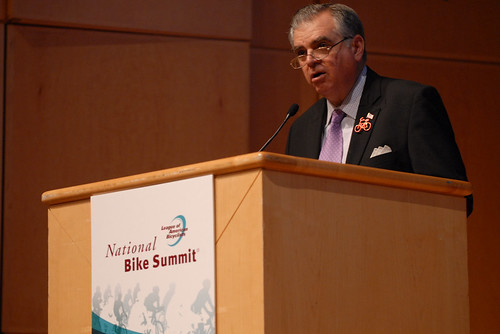Transportation Secretary affirms smart principles for US transportation system
 |
| National Bike Summit – Day two-8 Originally uploaded by BikePortland.org |
| DOT Secretary Ray LaHood speaks at the National Bike Summit in Washington, DC |
“Livable and Sustainable Communities.”
Those four words might not be at the top of the list of what one would expect to hear from the person in charge of how the federal government spends our tax dollars on all forms of transportation — ports, railroads, highways, interstates, sidewalks, bike lanes and more — but that’s exactly what U.S. Transportation Secretary Ray LaHood named as a primary goal for DOT while testifying before a Senate Committee yesterday (ahead of T4 America.)
In his remarks, he made it clear that DOT and the Obama administration see the deep connections between where and how we spend transportation dollars and the quality of life for everyday Americans.
One of the clear issues with our national transportation program since 1991 is that it’s been like a huge ship without a rudder — spending billions each year without any clear goals or vision for exactly what those billions should accomplish for us. Economic development? More travel options for everyone? Making transportation affordable and safe for all Americans?
After talking at length about the many challenges facing America, Secretary LaHood made it clear that DOT will be governed by some very clear principles in the future, including better quality of life as a goal for transportation spending:
With these great challenges it is essential that our transportation policies be framed so that we can meet these demands and at the same time be consistent with the major goals I have established for guiding the actions of the Department of Transportation: economic recovery; safety; and livable and sustainable communities will be the key organizing themes as we in the Department reformulate existing policies and develop new policy directions for the future.
You can download his full remarks from the committee web site here, (.pdf) but continue reading for a few select quotes:
…Since 1970, there has been a 173 percent increase in vehicle miles traveled (VMT; the total miles traveled by all U.S. vehicles), while the population grew 47 percent. In other words, VMT increased at almost four times the rate of population growth. Notwithstanding some anticipated reduction in VMT growth in the near term, reflecting the current downturn in the economy, this growth trend is clearly unsustainable.
In the past, population and economic growth have always led to large increases in highway travel. This is because most communities have built transportation systems that only allow people and goods to move by road. This Administration believes that people should have options to get to work, school, the grocery or the doctor that do not rely solely on driving. We want to transform our transportation system into a truly multimodal system with strong alternatives to driving in order to maximize highway capacity, combat traffic congestion, reduce our reliance on oil and decrease greenhouse gas emissions…
How aging America affects transportation:
Addressing the mobility needs of our citizens, we must keep in mind that an aging population will increasingly challenge our transportation system. The percentage of the population over 65 will almost double during the next 50 years, from 12 percent to 21 percent. Those older people – the people just graduating from college today – will demand a high level of mobility. This population should be able to maintain a high level of mobility without having to rely only on the automobile. Public transportation, that provides convenient and affordable transportation service, must be available. Transit-oriented, mixed-use development can especially benefit our older citizens. We need to continue our efforts to coordinate government and non-profit transportation services to make it easier for older adults – as well as people with disabilities and people with low incomes – to live independently and get where they need to go…
On livability:
Livable and Sustainable Communities
One of my highest priorities is to help promote more livable communities through safe, reliable and accessible surface transportation choices. Actions on many fronts will be required to enhance transportation’s contribution to strong and connected communities. A livable community requires that transportation solutions be tailored to the needs of the individual community or region as one-size-fits-all solutions are no longer viable.
Our initial focus will be on expanding the transportation choices available to American families. All segments of the population must have access to transportation services to get to work, housing, medical, educational, shopping, and other essential activities. Linking transportation and land-use planning to promote improved access to transit and creating walkable, bikeable communities will increase overall mobility and benefit all Americans.
The average working American family spends nearly 60 percent of its household budget on housing and transportation costs, making these two areas the largest expenses for American families. Affordable housing near transportation is an important element of livable communities and we have already started working with HUD to help provide American families with more choices for affordable housing near jobs and improve their range of transportation options while lowering their transportation costs.
Livability is not just an urban idea. The Department is working to improve livability of rural Americans as well. Many rural communities face tough choices as they try to attract economic development. They want to grow and attract new jobs but do not want to lose the unique character of the area. Transportation investments in these communities can be designed in a way to support new development while maintaining the small town character that makes these communities home.




















No Comments